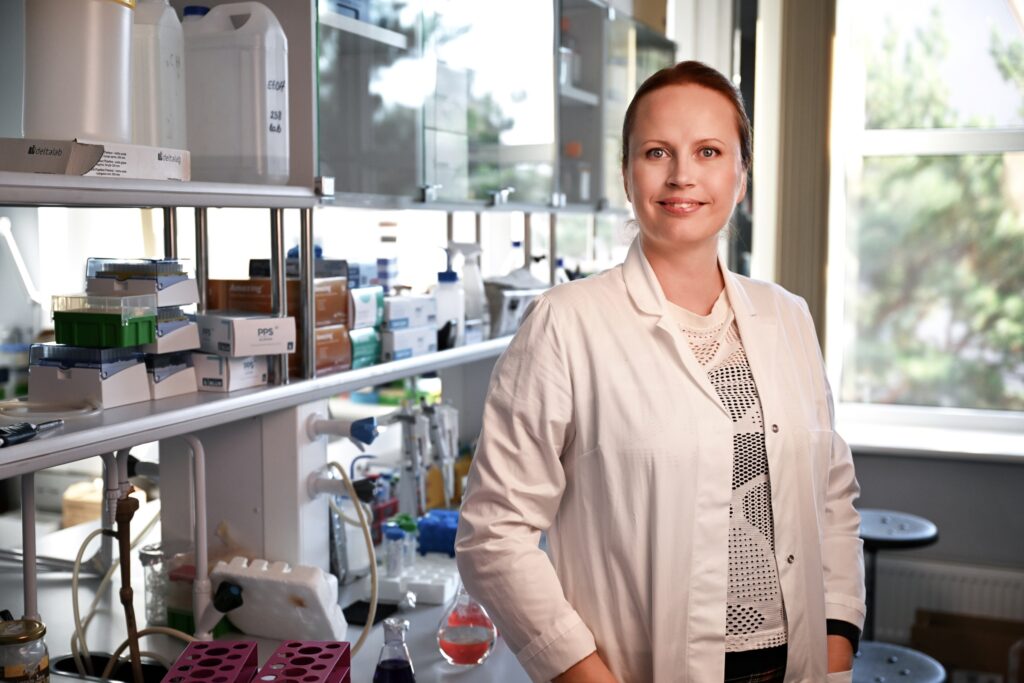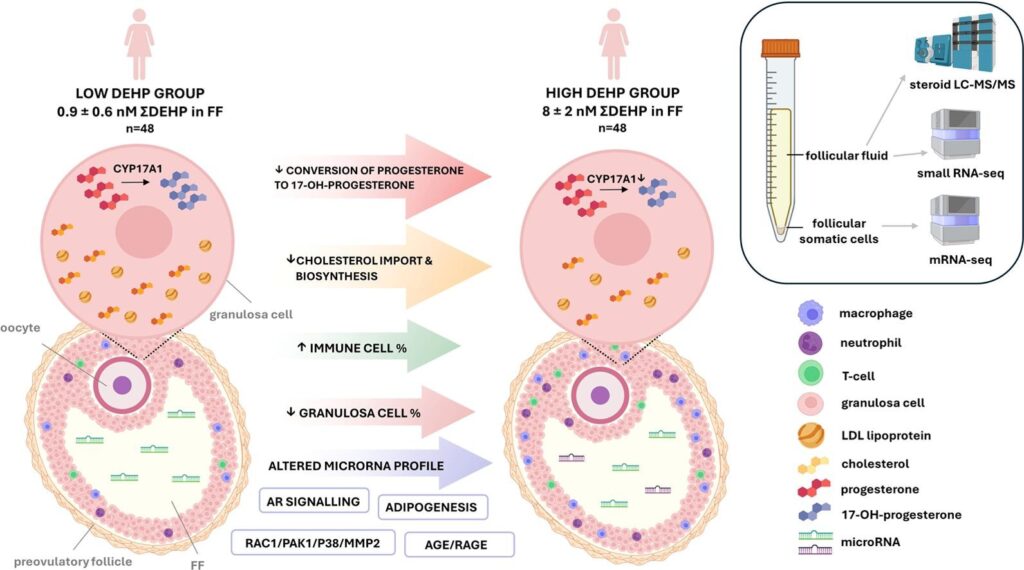Table of Contents
Tallinn University of Technology has emerged in recent years as a center of groundbreaking research into reproductive biology. In recent weeks, researchers at TalTech published two studies connected to their research into molecular mechanisms that underpin female fertility. These kinds of publications raise the profile of the TalTech team and will lead to more research.
Reproductive transcriptome research: breakthroughs in ovarian biology
The first of these studies appeared in the journal Nature Communications and provided a look at the transcriptomes of ovarian cortical follicles collected from children and adults, revealing an unanticipated degree of interfollicular heterogeneity, with potential ramifications for in vitro fertilization procedures. The second, appearing in the journal Environmental International, investigated the effects of plastic-softening chemicals on ovarian function and female fertility.
Agne Velthut-Meikas is the founder and leader of TalTech’s reproductive biology group, and has helmed its efforts since its inception in 2017. For Velthut-Meikas, an associate professor at TalTech, the group’s research developed both out of a personal interest – she once worked at an IVF clinic – as well as her own background in genomics research and molecular biology.
Her interest also dovetailed with the availability of new technologies, especially affordable next-generation sequencing, which allowed her to look at gene expression changes at a resolution previously either impossible or cost prohibitive. Service providers also popped up to do the sequencing, and new bioinformatics tools for the analysis became available for free use.
“We can now even do it at single-cell resolution,” says Velthut-Meikas, “which means we can analyze tens of thousands of single cells in a genome wide manner. We can see what cells are present, what they do, and how they differ between patient groups,” she says. “This has given us a lot of novel information.”

From clinics to the lab – advancing fertility preservation
That discovery engine has allowed Velthut-Meikas’ group to create a funnel of new information to inform the field of reproductive biology, and especially around female fertility and infertility. Infertility affects about 15 percent of all couples, and has different causes. Infertile couples often turn to IVF treatments to conceive, but IVF success rates are low.
Velthut-Meikas’ group has access to samples obtained from IVF clinics, and is focused on understanding female infertility, ovarian processes, and how healthy eggs mature. The Taltech researchers study the interplay between the egg and surrounding granulosa cells, with the aim of being able to better understand and potentially treat female infertility. RNA sequencing is the main technology workforce. Velthut-Meikas’ group actively cooperates with HansaBioMed Life Sciences. This Tallinn-based company specializes in the analysis of extracellular vesicles and exosomes. She also has close collaboration with IVF clinics throughout Estonia, which has made her work possible.
“Our main focus has been on identifying what the somatic cells in the ovary are doing, and how they are influencing female fertility or infertility,” says Velthut-Meikas. “We think by describing the environment where the oocyte is maturing, we can say a lot about the oocyte and how the ovary functions, which can say a lot if the oocyte is healthy,” she adds.
The oocyte, a developing egg, is never alone in the ovary, and is surrounded by granulosa cells and other cells that play important roles during maturation and fertilization. They feed the oocyte during its development and during fertilization act as a kind of quality filter for sperm cells. “At every stage there is interaction between different cell types,” she says. “This has been driving my scientific interest.”
In the recent Nature Communications paper, Velthut-Meikas’ team analyzed the transcriptomes from 120 cortical follicles collected from both children and adults for comparison. Child ovarian samples are at times collected for cancer patients who would otherwise suffer infertility from treatment, but might be able to use those samples for fertility restoration. The researchers found that the main types of follicles present in both groups were heterogeneous, with variations related to their extracellular matrix, theca cells, and microRNA profiles.

Most strikingly, the ovaries of both, children and adults, contain some follicles without any prominent expression of typical oocyte genes, meaning that only the granulosa cells have a function in these follicles. These so-called supporting follicles make up about a third of the ovarian follicle pool and were predicted to positively influence the follicles that contain transcriptionally active oocytes with a capacity to ovulate in the future.
They also found that cyclophosphamide, a common cancer treatment, interferes with interferon signaling in child follicles even at low doses that had previously been considered harmless. The researchers also concluded that cell morphology is not sufficient for categorizing follicles, and that additional markers are needed. Overall, they presented their findings as a trove of fresh data that could help improve follicular classification and fertility preservation techniques.
“We have to reconsider what the number of follicles means and how it affects the reproductive lifespan of a woman,” says Velthut-Meikas. She said that a positive outcome of the research was that the data from the child and adult samples was more or less the same. “This shows that tissue preserved for young patients can be viable,” she says. “There were no big differences. This was a good thing.”
Linking environmental chemicals to reproductive health challenges
In the second new study, the researchers reported on how DEHP (diethylhexyl phthalate), a plastic-softening chemical found in some household products, can damage female fertility. DEHP is used in different products, such as food containers, toys, and medical products. The chemical easily enters the environment and is present in drinking water, for example. DEHP is banned for the most part in the EU, though it’s still allowed to be used in medical products. Blood storage bags, for example, contain DEHP.
In the Environment International study, the TalTech researchers and partners in Sweden looked at IVF patient samples and determined that DEHP levels were impacting the production of sex hormones. They also identified a connection between DEHP and inflammatory processes.
“There have been many studies showing that if you measure blood plasma or urine, you can find a lot of chemicals there, but nobody has asked how widely they are distributed in other tissues,” says Velthut-Meikas. “We found that for women with high levels of DEHP in their ovaries, there was a big change in expression of genes responsible for steroid hormone synthesis,” she says. “And women with higher levels of these chemicals respond more poorly to IVF procedures.”

This information could help identify the reasons for female infertility as well as to develop better tests ahead of an IVF procedure. The findings are also inspiring further research at TalTech.
“We want to better understand what’s happening in this kind of heterogeneous cell culture when it’s exposed to chemicals,” says Velthut-Meikas. Part of the effort will focus on studying miRNAs and their involvement in molecular communication between cells in the ovary. It could also inspire other research groups to do the same.
“This is a tiny field that I would like to talk about more,” says Velthut-Meikas, “and to tell other reproductive biologists that this is something we should look more into.”
This article is written by Justin Petrone. This article was funded by the European Regional Development Fund through Estonian Research Council.
If this dive into fertility has sparked your curiosity, don’t just let it swim away – head over to our next article to uncover more about the science of male fertility health! Read more about how One of the largest male infertility genetic studies improves molecular diagnostics and personalized management of andrology patients!
 Back
Back



